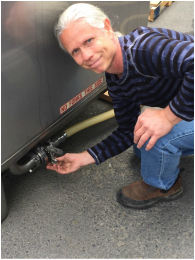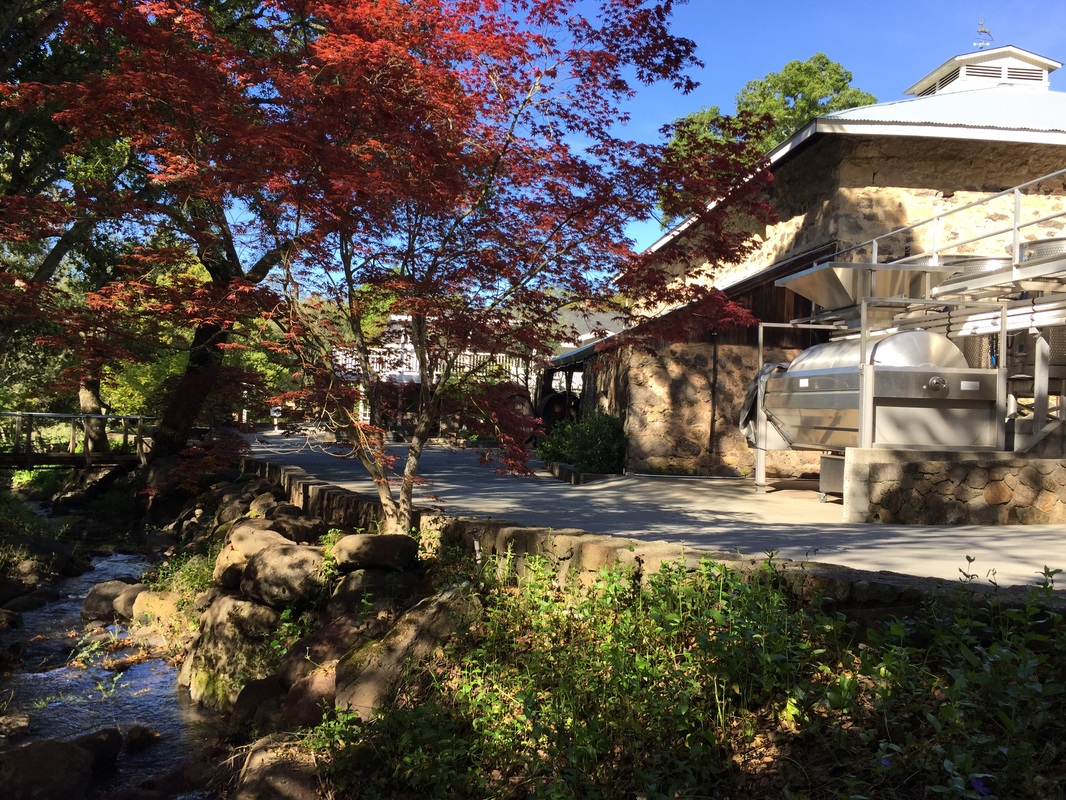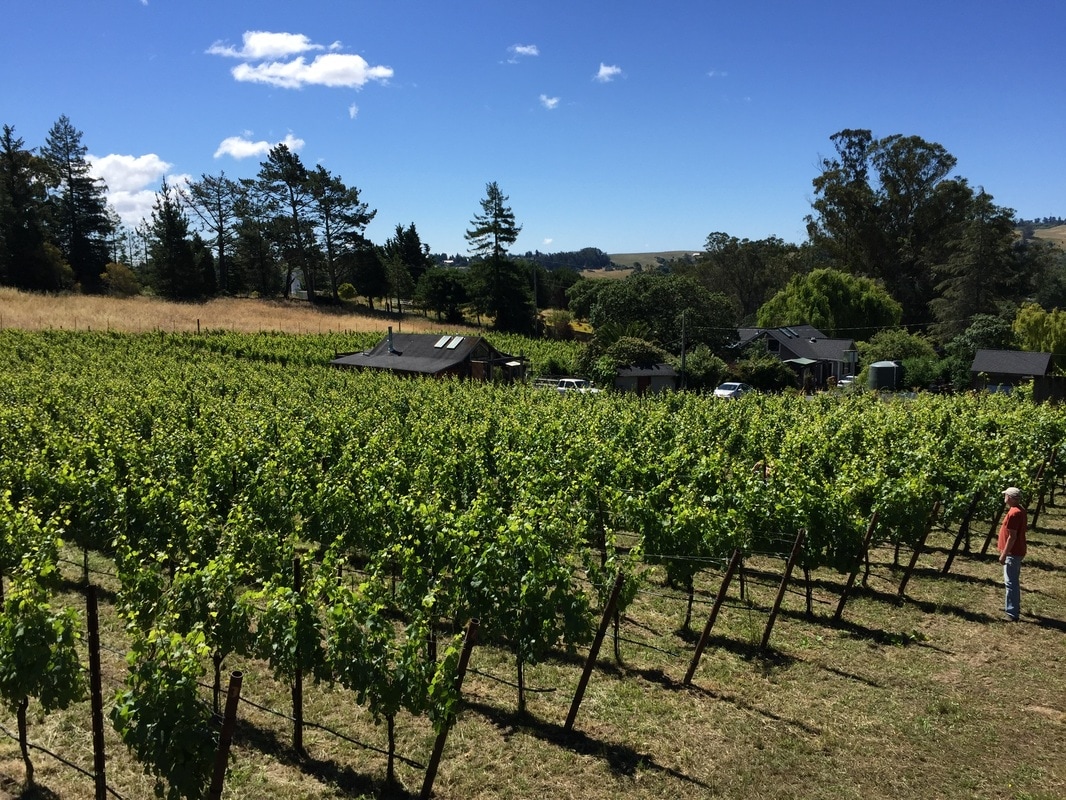Bob Bolan
|
Bob Bolan has quietly become known among his peers as one of Napa Valley’s premier winemakers. His wines are supple and expressive with remarkable consistency from vintage to vintage. Bob has a Masters degree from UC Davis and spent six vintages developing his craft at Stags’ Leap Winery. He worked another five vintages in Sonoma County and has been making wines for Bremer Family since 2003. Prior to turning his attention to wine, Bob worked ten years as a process design engineer and business consultant.
|
Bremer Family Winery
I feel priviledged to spend my days working in such a beautiful setting. This 130 year old building is home to both Bremer Family Winery and Bob Bolan Wines. Thank you, Laura & John Bremer!
Bremer Family Winery is open for tastings by appointment. If you are planning a visit to the winery, I hope you'll let me know. I'd love to meet you! I don't have a tasting permit for my Pinot Noir, but you can taste the wines I make for Bremer when you visit.
Bremer Family Winery is open for tastings by appointment. If you are planning a visit to the winery, I hope you'll let me know. I'd love to meet you! I don't have a tasting permit for my Pinot Noir, but you can taste the wines I make for Bremer when you visit.
Kiamberell Vineyard
This tiny, one-and-a-half-acre vineyard located in the hills west of Sebastopol is in the coolest part of the Russian River Valley AVA just south of the Green Valley AVA. It is also within the much larger Sonoma Coast AVA. All three appellations are considered prime growing regions for Pinot Noir.
Cool growing conditions allow for slow ripening and longer fruit hang time, yielding a more complex flavor profile while maintaining good acidity. Its proximity to the Pacific Ocean and the predominantly westerly breezes account for the cool temperatures of this vineyard site. Additional cooling is provided in the form of fog that originates over the ocean and enters the Russian River Valley through the Petaluma Gap of the coastal mountains. This part of the Russian River is the first place where the fog rolls in most evenings and the last place where it burns off the following day, making it the coolest part of Russian River Valley.
Known locally as Goldridge soils, sandy loam sits over a sublayer of fractured sandstone formed three to five million years ago from the remains of an ancient inland sea. The excellent drainage and relatively low fertility provided by these soils result in very small berries with highly concentrated flavors…and of course much more flavorful wine.
The vineyard is planted to three different Dijon clonal selections of Pinot Noir. Clone 777, known for its black fruit aromatics and earthy notes, serves a base while clones 667 and 115 contribute supple tannins and red fruit flavors (dark cherry, raspberry, and strawberry), as well as exotic notes of leather, roses and anise. The three clones comprising this field blend are fermented together to make a wine that is singularly complex.
Each vine is tended by hand using organic farming practices under the attentive eyes of owners Don and Jan Plenty. Cane-pruning allows each vine to be balanced according to its individual vigor, and a permanent cover crop of native vegetation provides a habitat for beneficial insects.
Cool growing conditions allow for slow ripening and longer fruit hang time, yielding a more complex flavor profile while maintaining good acidity. Its proximity to the Pacific Ocean and the predominantly westerly breezes account for the cool temperatures of this vineyard site. Additional cooling is provided in the form of fog that originates over the ocean and enters the Russian River Valley through the Petaluma Gap of the coastal mountains. This part of the Russian River is the first place where the fog rolls in most evenings and the last place where it burns off the following day, making it the coolest part of Russian River Valley.
Known locally as Goldridge soils, sandy loam sits over a sublayer of fractured sandstone formed three to five million years ago from the remains of an ancient inland sea. The excellent drainage and relatively low fertility provided by these soils result in very small berries with highly concentrated flavors…and of course much more flavorful wine.
The vineyard is planted to three different Dijon clonal selections of Pinot Noir. Clone 777, known for its black fruit aromatics and earthy notes, serves a base while clones 667 and 115 contribute supple tannins and red fruit flavors (dark cherry, raspberry, and strawberry), as well as exotic notes of leather, roses and anise. The three clones comprising this field blend are fermented together to make a wine that is singularly complex.
Each vine is tended by hand using organic farming practices under the attentive eyes of owners Don and Jan Plenty. Cane-pruning allows each vine to be balanced according to its individual vigor, and a permanent cover crop of native vegetation provides a habitat for beneficial insects.
Winemaking Is Easy!
Well...not really, but it's not that complicated either. Here's my winemaking philosophy in a nutshell:
1) Start with the best raw materials. Where grapes are grown matters. That's why I choose to work in California, and that's why I source Pinot Noir from the coolest part of Russian River Valley in Sonoma County.
2) Allow the fruit to fully ripen for maximum flavor development and phenolic maturity (soft tannins).
3) Age the wine in good barrels, but don't go overboard with new oak. The delicate flavors of Pinot Noir can easily be masked by too much new oak.
4) Blend for mouthfeel (texture). Understanding the primary factors that affect texture (acidity, alcohol and tannin content) and how they interact is key to achieving a silky mouthfeel and long finish.
In a word, what I strive for with every wine I make is balance. A balanced wine is seamless, integrated and expressive.
1) Start with the best raw materials. Where grapes are grown matters. That's why I choose to work in California, and that's why I source Pinot Noir from the coolest part of Russian River Valley in Sonoma County.
2) Allow the fruit to fully ripen for maximum flavor development and phenolic maturity (soft tannins).
3) Age the wine in good barrels, but don't go overboard with new oak. The delicate flavors of Pinot Noir can easily be masked by too much new oak.
4) Blend for mouthfeel (texture). Understanding the primary factors that affect texture (acidity, alcohol and tannin content) and how they interact is key to achieving a silky mouthfeel and long finish.
In a word, what I strive for with every wine I make is balance. A balanced wine is seamless, integrated and expressive.
Serving Temperature
Because I put so much effort into achieving balance and want you to experience my wines at their best, I want to talk about one more factor that affects texture and flavor expression. Serving temperature is more important than most people realize. Unlike what you may have heard, red wine should not be served at room temperature...at least not most California reds. For optimal enjoyment I recommend serving my Pinot Noir between 62 and 65°F. Assuming your wine cellar is at 58 to 60°F, I suggest keeping the wine in your cellar until you're ready to serve it. (It will warm up in the glass.)
When a wine is served too warm the alcohol becomes more noticeable, and the wine can taste thin, lacking viscosity or body. When a wine is served too cold the aroma is suppressed, and the finish becomes shorter. When I take a bottle of red wine to a restaurant, I often chill it for a few minutes in my refrigerator before leaving the house to account for any warming that will occur during transport. In situations where I've had the bottle in my car all day, I'll ask the waiter for a bucket of ice so I can cool the wine to the proper temperature prior to drinking it. The ice bucket cools only the bottom half of the bottle; so be sure to tip the bottle back and forth a couple times to achieve uniform temperature. Also be sure to take the wine out of the ice after a few minutes; otherwise, it will be chilled too much.
When a wine is served too warm the alcohol becomes more noticeable, and the wine can taste thin, lacking viscosity or body. When a wine is served too cold the aroma is suppressed, and the finish becomes shorter. When I take a bottle of red wine to a restaurant, I often chill it for a few minutes in my refrigerator before leaving the house to account for any warming that will occur during transport. In situations where I've had the bottle in my car all day, I'll ask the waiter for a bucket of ice so I can cool the wine to the proper temperature prior to drinking it. The ice bucket cools only the bottom half of the bottle; so be sure to tip the bottle back and forth a couple times to achieve uniform temperature. Also be sure to take the wine out of the ice after a few minutes; otherwise, it will be chilled too much.
Corks: They're All The Same, Right?
Actually no; corks are not all the same. About 1% of natural corks contain trace amounts of the chemical compound 2,4,6-trichloroanisole (TCA), otherwise known as cork taint. A few parts per trillion TCA in wine will affect its aroma...and not in a good way. TCA kills the fruit and gives wine a musty, wet cardboard-like aroma. This is what people are referring to when they say a wine is corked. It's also why your waiter will pour a small taste for you to test before serving a wine to your dinner guests at a restaurant.
A lesser known attribute of corks is the variability in permeability, or oxygen transfer rate (OTR), from one cork to the next. Because corks are made from the bark of cork oak trees, there can be substantial differences in density and permeability from one cork to the next. Research has shown this difference in permeability can be as high as 23-fold, meaning one bottle of wine could theoretically age/oxidize 23 times faster than another bottle from the same case. Anyone who enjoys drinking older wines has experienced bottle-to-bottle variation and is familiar with the uncertainty of aging wine.
Because I don't want you to experience either of these issues, I use Diam corks for my Pinot Noir. Diam is an example of a technical grade cork. They are manufactured from natural cork particles that have been washed in liquid carbon dioxide to extract any TCA and then formed into corks using a binder similar to that used for sparkling wine corks. Diam corks are not only guaranteed to be TCA-free, but due to their composite nature, they provide a uniform and predictable oxygen transfer rate. Assuming the wine is properly stored (i.e., at a cool, constant temperature with the bottles either on their sides or upside down to keep the cork wet), you should see very little bottle-to-bottle variation.
A lesser known attribute of corks is the variability in permeability, or oxygen transfer rate (OTR), from one cork to the next. Because corks are made from the bark of cork oak trees, there can be substantial differences in density and permeability from one cork to the next. Research has shown this difference in permeability can be as high as 23-fold, meaning one bottle of wine could theoretically age/oxidize 23 times faster than another bottle from the same case. Anyone who enjoys drinking older wines has experienced bottle-to-bottle variation and is familiar with the uncertainty of aging wine.
Because I don't want you to experience either of these issues, I use Diam corks for my Pinot Noir. Diam is an example of a technical grade cork. They are manufactured from natural cork particles that have been washed in liquid carbon dioxide to extract any TCA and then formed into corks using a binder similar to that used for sparkling wine corks. Diam corks are not only guaranteed to be TCA-free, but due to their composite nature, they provide a uniform and predictable oxygen transfer rate. Assuming the wine is properly stored (i.e., at a cool, constant temperature with the bottles either on their sides or upside down to keep the cork wet), you should see very little bottle-to-bottle variation.



